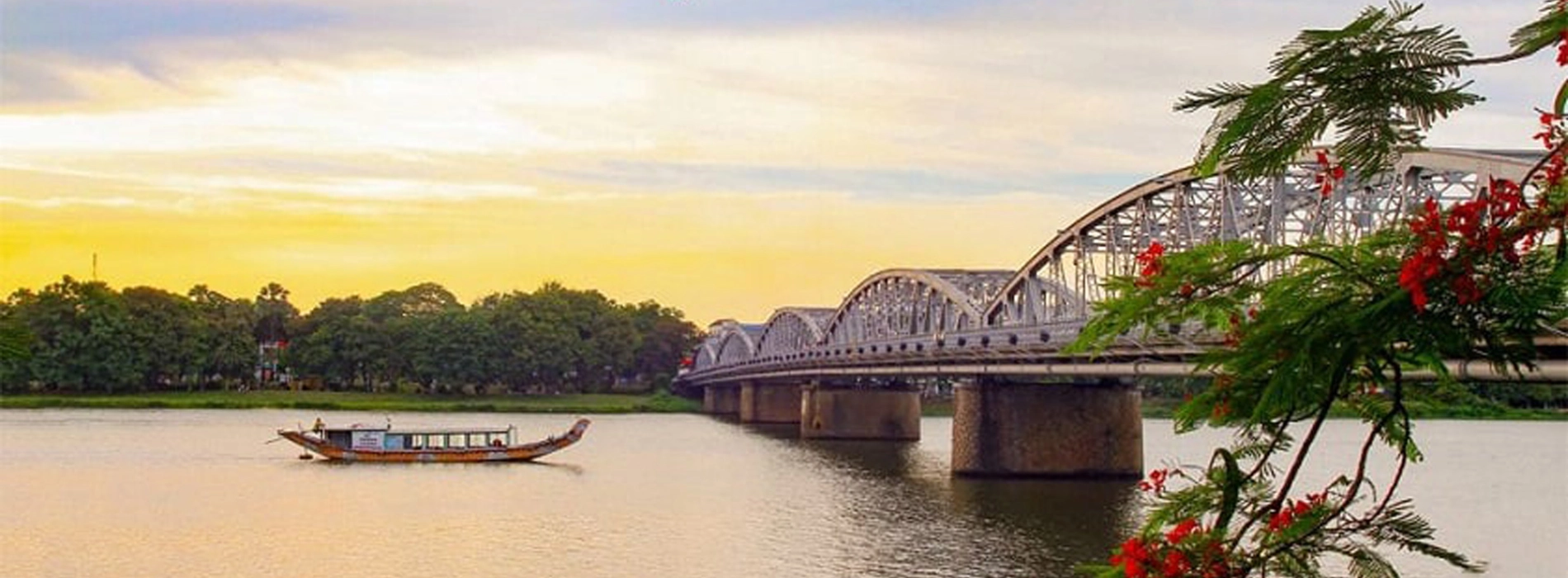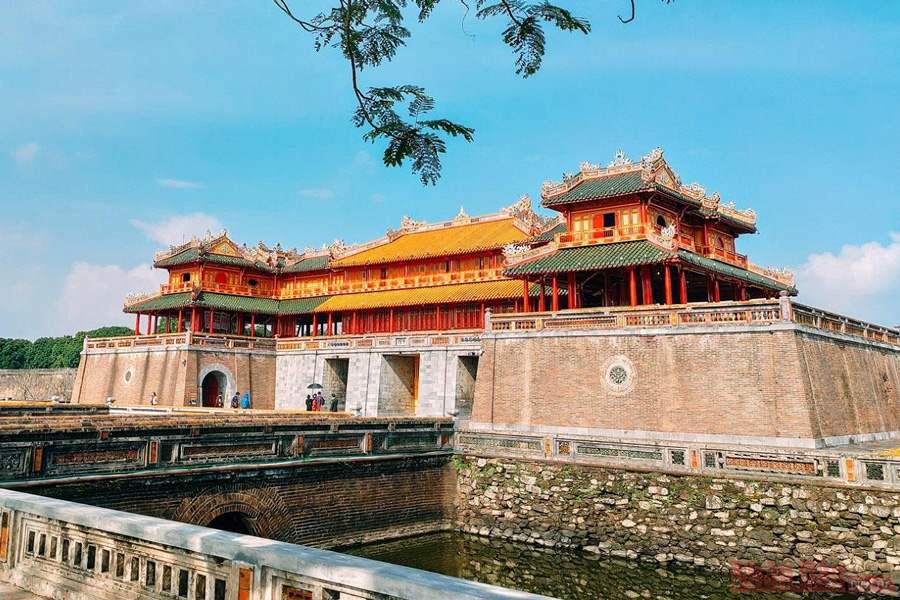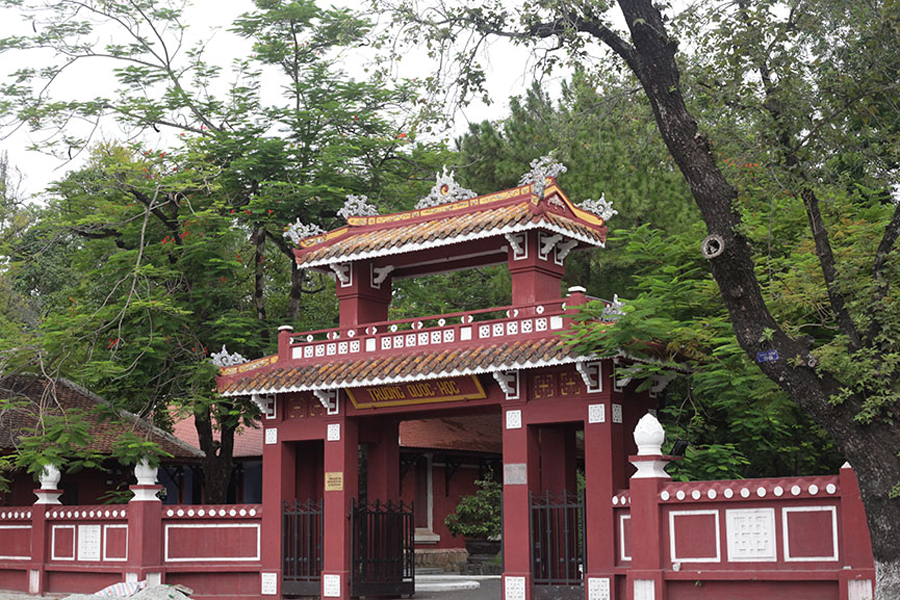Trang Tien Bridge

Trang Tien Bridge, a mesmerizing emblem of Hue, Vietnam, gracefully arches over the Perfume River, encapsulating a rich tapestry of history and architectural charm. Originally erected during the French colonial era in 1899, the bridge has evolved into a symbol of cultural heritage and endurance. Its distinctive design, marked by elegant arches and captivating ornamentation, speaks to the artistic prowess of its creators. As day transitions to night, Trang Tien Bridge transforms into a luminous spectacle, casting a radiant reflection upon the tranquil waters below, captivating the hearts of both locals and visitors alike. Beyond its aesthetic allure, the bridge stands as a functional conduit, facilitating the flow of traffic between the Phu Hoa district and the city center. Stepping onto Trang Tien Bridge is a journey through time, a connection to the narratives woven into the fabric of Hue's past and present.
Trang Tien Bridge story begins in the late 19th century during the French colonial period when it was conceived and constructed in 1899 under the watchful eye of French engineer Gustave-Émile Blanchard. Originally named "Pont Blanchard" in his honor, the bridge aimed to enhance connectivity and facilitate trade between the bustling Phu Hoa district and the city center.
The bridge's design reflects the prevailing architectural aesthetics of the time, showcasing a harmonious blend of European and Asian influences. Characterized by graceful arches and intricate detailing, Trang Tien Bridge became more than a mere structure; it evolved into a symbol of the city's sophistication and cultural fusion.
 The beauty of Trang Tien Bridge - Hue
The beauty of Trang Tien Bridge - Hue
As the years unfolded, Trang Tien Bridge became a silent witness to the twists and turns of Vietnam's tumultuous history. The bridge endured the seismic shifts of power during the Vietnam War, a conflict that left an indelible mark on the nation. It bore witness to the comings and goings of armies, the resilience of the local population, and the toll exacted on infrastructure. The scars of war manifested on the bridge, as it suffered damage, reflecting the broader devastation faced by the country.
However, with the cessation of hostilities, a period of reconstruction and renewal began. Trang Tien Bridge, symbolic of both the scars and the healing of Vietnam, underwent extensive restoration efforts. The rehabilitation not only aimed at physical reconstruction but also at preserving the bridge's historical and cultural significance. The restoration process became a testament to the resilience and determination of the people of Hue, who sought to reclaim their heritage and rebuild their city.
In its renewed state, Trang Tien Bridge emerged as a radiant symbol of the city's endurance, with its distinctive arches once again gracing the Perfume River. The illuminated nightscape, where the bridge reflects in the tranquil waters below, became a postcard image, drawing locals and tourists alike. The bridge transformed into more than a functional crossing; it became a cultural icon, embodying the spirit of Hue and its ability to rise from the ashes of history.
.jpg) Trang Tien Bridge - The Charming Beauty in Hue
Trang Tien Bridge - The Charming Beauty in Hue
Today, Trang Tien Bridge stands as a living chronicle of Hue's past, a testament to the resilience of its people, and a bridge connecting generations. Its arches stretch beyond the physical expanse of the Perfume River, reaching into the collective memory of the city. Visitors crossing the bridge are not merely traversing a river; they are journeying through time, engaging with the layers of history embedded in each stone and pillar.
As one strolls across Trang Tien Bridge, surrounded by the subtle hum of the city and the gentle flow of the Perfume River, it becomes a contemplative experience. The bridge, with its storied past and restored grandeur, invites reflection on the cyclical nature of history, the endurance of heritage, and the transformative power of resilience. Trang Tien Bridge is not just a passage; it is a living testament to the soul of Hue, a city that has weathered storms and emerged with its cultural identity intact, reflected in the elegant arches that continue to span the Perfume River.
The best time to visit Trang Tien Bridge in Hue, Vietnam, is generally during the months of February to April and September to November. These periods coincide with the city's more temperate weather and lower chances of rain, making outdoor exploration, including visits to landmarks like Trang Tien Bridge, more enjoyable.
1. Spring (February to April): This season offers mild temperatures, blooming flowers, and generally pleasant weather. Spring is considered an excellent time to explore Hue, as the temperatures are not too hot, and there is less rainfall.
2. Autumn (September to November): Similar to spring, fall in Hue brings comfortable temperatures and less precipitation. It's a favorable time for sightseeing, and the landscape is often lush and green after the rainy season.
Hue experiences a tropical climate, characterized by a distinct wet season (from May to August) and a dry season (from November to April). While the wet season can bring heavy rains and high humidity, the dry season offers more stable and comfortable conditions for travel.
Trang Tien Bridge is located in the central part of Hue, Vietnam, spanning the Perfume River. There are several notable attractions and points of interest in close proximity to Trang Tien Bridge. Here are some places you may want to explore in the vicinity:
1. Hue Imperial City (The Citadel): A UNESCO World Heritage Site, the Imperial City is a vast complex with walls, gates, and palaces that served as the political and cultural center of the Nguyen Dynasty. It's located a short distance from Trang Tien Bridge.

2. Dong Ba Market: One of the oldest and most vibrant markets in Hue, Dong Ba Market is known for its bustling atmosphere and a wide array of local products, including fresh produce, handicrafts, and traditional Vietnamese cuisine.
.jpg)
3. Thien Mu Pagoda: Situated on the northern bank of the Perfume River, Thien Mu Pagoda is one of the oldest and most beautiful pagodas in Hue. It offers scenic views of the river and surrounding landscape.
.jpg)
4. Hue National School: Near the Trang Tien Bridge, you can find the historic Hue National School, also known as Quoc Hoc High School. The school, founded in 1896, has a distinctive architectural style and has educated many prominent figures in Vietnam.

To reach the enchanting Trang Tien Bridge in Hue, Vietnam, various transportation options cater to different preferences and starting points. If arriving by air, Phu Bai International Airport serves as the nearest air travel hub, and from there, a taxi or pre-arranged transfer can seamlessly transport you to the heart of Hue. Travelers opting for the scenic route can choose to take a train to the Hue Railway Station, where local transportation, such as taxis, awaits to convey them to Trang Tien Bridge. Long-distance buses also connect major cities to Hue, offering a budget-friendly option for those seeking an overland journey.
For those preferring flexibility, car rentals or private car services are available, providing convenience and personalized travel experiences. Once in Hue, navigating the city to reach Trang Tien Bridge is easily accomplished through taxis, cyclos, motorbike taxis, or even on foot, allowing visitors to absorb the cultural richness of this historic Vietnamese destination.
See more: The Central of Vietnam Explorer